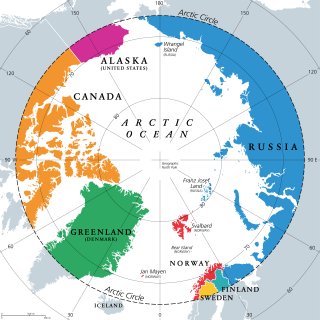The Arctic, Alaska, and Climate Change
The Arctic is warming nearly three times faster than the rest of the planet.1 Since 1970, global average temperature has increased around 1.7 degrees Fahrenheit (°F). During the same period, temperatures in Alaska have gone up by about 4.2°F.2 The Arctic and Alaska are seeing big impacts because of climate change. These impacts include melting sea ice, thawing permafrost, melting glaciers, more frequent extreme weather events, ocean acidification, and warming oceans.3
These changes can greatly affect communities, human health, ecosystems, biodiversity, infrastructure, and economies in both the Arctic region as well as global systems. Many of the changes in the Arctic threaten unique ecosystems and ways of life. Erosion and thawing permafrost have already forced some Alaska Native communities to start to relocate.
This web area has information about climate change in the Arctic Circle and the state of Alaska. It also gives a summary of Arctic climate science, indicators (signs) of change, impacts on people living there, and actions that respond to these changes. This page introduces the Arctic region, resources, and how to navigate the web area.
-
Drivers of Change in the Arctic
Different factors make climate change worse in the Arctic region.
-
Observed Changes in the Arctic
The Arctic is facing melting ice; thawing permafrost; more extreme events; and warmer, more acidic oceans.
-
Community Impacts
Climate change is greatly affecting food, health, and infrastructure in communities.
-
Taking Action: Adaptation
Communities in Alaska and the Arctic are taking steps to adapt to a changing climate.
-
Addressing Climate Change in the Arctic
Many groups are working together to better understand change in the Arctic and how to respond.
The Arctic

The Arctic is the northern polar region. It is often defined as roughly 66° north of the equator. Eight nations have land within the Arctic Circle. These are Canada, the Kingdom of Denmark (includes Greenland), Finland, Iceland, Norway, the Russian Federation, Sweden, and the United States. The Arctic Ocean, which encompasses about 70% of the Arctic Circle, is largely covered by sea ice in the winter. The Arctic hosts unique geographic features and diverse ecosystems, with many plants and animals that are only found in this region.
The ecosystems of the Arctic support many different communities. Nearly 4 million people call the Arctic home, and Indigenous Peoples make up around 9% of the total population.4 More than 90% of the settlements in the Arctic have fewer than 5,000 people, and almost two-thirds are built on permafrost.5
Alaska
About one-third of Alaska’s land mass is in the Arctic Circle. Alaska is the largest U.S. state by land area. Alaska is home to about 740,000 people,6 including 229 federally recognized Tribes, which make up about a fifth of the Alaskan population.7 The Arctic ecoregion is mostly tundra largely characterized by plants like lichens and mosses, and is underlain by permafrost. The interior of Alaska is the boreal region, or taiga, with many trees and shrubs.8 Alaska has the longest coastline of any state, with approximately 33,900 miles of diverse shoreline.9 Over half of Alaska’s land is national parks, national forests, or wildlife refuges. These large areas of natural beauty make Alaska a popular tourist spot. Besides tourism, commercial fishing and oil and gas extraction are important parts of the state’s economy.
References
1 Arctic Monitoring and Assessment Programme (AMAP). (2021). Arctic Climate Change Update 2021: Key Trends and Impacts. Summary for Policy-Makers. AMAP. https://www.amap.no/documents/doc/arctic-climate-change-update-2021-key-trends-and-impacts.-summary-for-policy-makers/3508, p. 4
2 Marvel, K., W. Su, R. Delgado, et al. (2023). Ch. 2. Climate trends. In: Fifth National Climate Assessment. Crimmins, A.R., C. W. Avery, K.E. Kunkel, et al., Eds. U.S. Global Change Research Program., p. 2-11.
3 Huntington, H. P., C. Strawhacker, J. Falke, et al. (2023). Ch. 29. Alaska. In: Fifth National Climate Assessment. Crimmins, A. R., C. W. Avery, D. R. Easterling, et al., Eds. U.S. Global Change Research Program.
4 AMAP. (2021). Arctic Climate Change Update 2021: Key Trends and Impacts. Summary for Policy-Makers. AMAP. https://www.amap.no/documents/doc/arctic-climate-change-update-2021-key-trends-and-impacts.-summary-for-policy-makers/3508, p. 9.
5 AMAP. (2021). Arctic Climate Change Update 2021: Key Trends and Impacts. Summary for Policy-Makers. AMAP. https://www.amap.no/documents/doc/arctic-climate-change-update-2021-key-trends-and-impacts.-summary-for-policy-makers/3508, p. 9.
6 United States Census Bureau. (2024). QuickFacts: Alaska, Population Estimates, July 1, 2024. Retrieved December 19, 2024 from https://www.census.gov/quickfacts/fact/table/AK/PST045222
7 Huntington, H. P., C. Strawhacker, J. Falke, et al. (2023). Ch. 29. Alaska. In: Fifth National Climate Assessment. Crimmins, A. R., C. W. Avery, D. R. Easterling, et al., Eds. U.S. Global Change Research Program., p. 29-15.
8 United States National Park Service. (2024). Alaska Nature and Science: Alaska’s Ecoregions. Accessed December 11, 2024 from https://www.nps.gov/subjects/aknatureandscience/akecoregions.htm
9 NOAA Office for Coastal Management. Shoreline Mileage of the United States. Accessed December 11, 2024 from https://coast.noaa.gov/data/docs/states/shorelines.pdf
